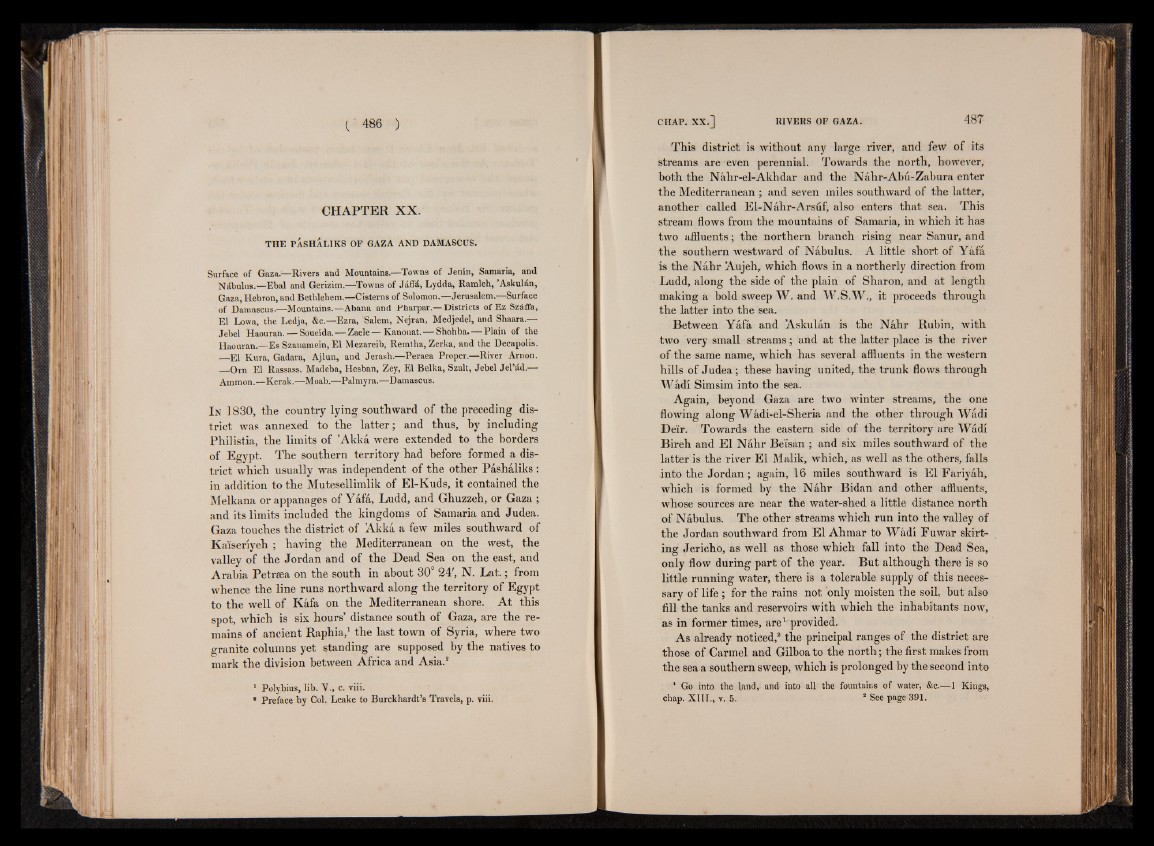
CHAPTER XX.
THE PASHAIJKS OF GAZA AND DAMASCUS.
Surface of Gaza.—Rivers and Mountains.—Towns of Jenin, Samaria, and
Nibulus.—Ebal and Gerizim.—Towns of Jdfld, Lydda, Ramleh, ’Askuldn,
Gaza, Hebron, and Bethlehem.—Cisterns of Solomon.—Jerusalem.—Surface
of Damascus.—Mountains.—Abana and Pharpar. Districts ofEzSz&ffa,
El Lowa, the Ledja, &c.—Ezra, Salem, Nejran, Medjedel, and Shaara.—
Jebel Haouran.— Soueida. — Zaele— Kanouat. — Shohba. — Plain of the
Haouran.—Es Szauamein, El Mezareib, Remtha, Zerka, and the Decapolis.
—El Kura, Gadara, Ajlun, and Jerash.—Peraea Proper.—River Arnon.
—Orn El Rassass, Madeba, Hesban, Zey, El Belka, Szalt, Jebel Jel’dd.—
Ammon.—Kerak.—Moab.—Palmyra.—Damascus.
I n 1830, the country lying southward of the preceding district
was annexed to the latter; and thus, by including
Philistia, the limits of ’Akka were extended to the borders
of Egypt. The southern territory had before formed a district
which usually was independent of the other Pashaliks:
in addition to the Mutesellimlik of El-Kuds, it contained the
Melkana or appanages of Yafa, Ludd, and Ghuzzeh, or Gaza ;
and its limits included the kingdoms of Samaria and Judea.
Gaza touches the district of Akka a few miles southward of
Kaiseriyeh ; having the Mediterranean on the west, the
valley of the Jordan and of the Dead Sea on the east, and
Arabia Petrsea on the south in about 30° 24', N. Lat.; from
whence the line runs northward along the territory of Egypt
to the well of Kafa on the Mediterranean shore. At this
spot, which is six hours’ distance south of Gaza, are the remains
of ancient Raphia,1 the last town of Syria, where two
granite columns yet standing are supposed by the natives to
mark the division between Africa and Asia.8
1 Polybius, lib. V., c. viii.
* Preface by Col. Leake to Burckhardt’s Travels, p. viii.
This district is without any large river, and few of its
streams are even perennial. Towards the north, however,
both the Nahr-el-Akhdar and the Nahr-Abu-Zabura enter
the Mediterranean ; and seven miles southward of the latter,
another called El-Nahr-Arsuf, also enters that sea. This
stream flows from the mountains of Samaria, in which it has
two affluents; the northern branch rising near Sanur, and
the southern westward of Nabulus. A little short of Yafa
is the Nahr ’Aujeh, which flows in a northerly direction from
Ludd, along the side of the plain of Sharon, and at length
making a bold sweep W. and W.S.W., it proceeds through
the latter into the sea.
Between Yafa and ’Askulan is the Nahr Rubin, with
two very small streams; and at the latter place is the river
of the same name, which has several affluents in the western
hills of Judea; these having united, the trunk flows through
Wadi Simsim into the sea.
Again, beyond Gaza are two winter streams, the one
flowing along Wadi-el-Sheria and the other through Wadi
Deir. Towards the eastern side of the territory are Wadi
Bireh and El Nahr Beisan ; and six miles southward of the
latter is the river El Malik, which, as well as the others, falls
into the Jordan; again, 16 miles southward is El Fariyah,
which is formed by the Nalir Bidan and other affluents,
whose sources are near the water-shed a little distance north
of Nabulus. The other streams which run into the valley of
the Jordan southward from El Ahmar to Wadi Fuwar skirting
Jericho, as well as those which fall into the Dead Sea,
only flow during part of the year. But although there is so
little running water, there is a tolerable supply of this necessary
of life ; for the rains not only moisten the soil, but also
fill the tanks and reservoirs with which the inhabitants now,
as in former times, are1 provided.
As already noticed,2 the principal ranges of the district are
those of Carmel and Gilboato the north; the first makes from
the sea a southern sweep, which is prolonged by the second into
1 Go into thefand, and into all the fountains of water, &c.— 1 Kings,
chap. XIII., v. 5. 2 See page 391.